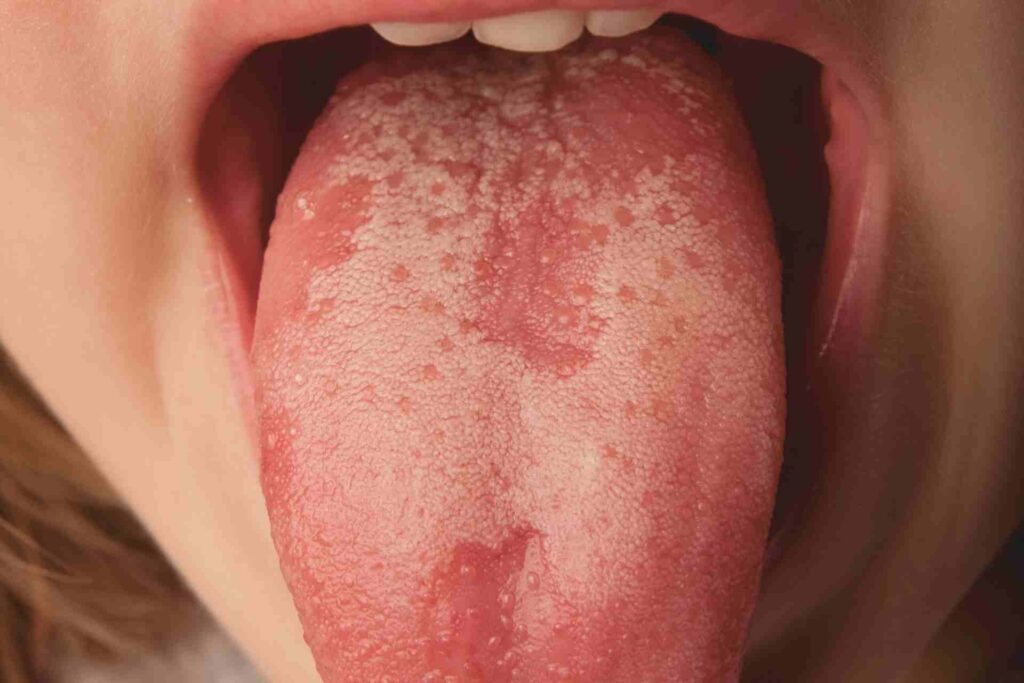What is caviar tongue? Caviar tongue is a harmless condition where small, dark veins appear under your tongue, resembling caviar. It’s caused by dilated blood vessels (lingual varicosities) that typically occur with age. While usually harmless, see your dentist if the veins become painful, swollen, or change color.
Highlights
- Caviar tongue appears as small, dark veins or bumps under the tongue.
- It’s most common in older adults and generally harmless.
- Caused by enlarged blood vessels (lingual varicosities) from aging or circulation issues.
- Most cases don’t need treatment, but changes in color, pain, or swelling should be evaluated.
- Regular dental checkups help monitor and maintain tongue and oral health.
What Exactly Is “Caviar Tongue”?
Have you ever looked under your tongue and noticed tiny, dark veins that look like clusters of caviar? Don’t worry, it’s usually nothing to fear. This harmless condition, called caviar tongue, may look strange but is rarely serious.
Caviar tongue is more common than most people realize, especially as we age. Let’s break down what causes it, what it looks like, and when it might be worth checking with your dentist.
What is Caviar Tongue?

Caviar tongue gets its name from its appearance, small, round, dark-blue or purple bumps under the tongue that resemble caviar pearls. These bumps are dilated veins, known medically as lingual varicosities, that form when blood vessels lose elasticity or expand over time.
Related Reading: Chlamydia Bumps on Tongue
While the sight can be surprising, it’s important to know that caviar tongue is almost always benign and doesn’t affect your speech, taste, or comfort.
How It Looks
You might notice:
- Dark blue, purple, or blackish spots under the tongue
- Soft, vein-like bumps that are non-painful
- Clusters that become more visible when you lift your tongue
The veins usually appear on both sides and flatten slightly when you press on them, a key sign that they’re varicose veins, not growths.
What Causes Caviar Tongue?

Caviar tongue forms when veins under your tongue expand or twist. While it’s typically a natural part of aging, certain factors can make it more noticeable.
Aging
As we get older, blood vessels become weaker and lose elasticity. This makes them more likely to dilate and appear as visible veins. It’s why caviar tongue is most common in people over 50.
Genetics
If you’re prone to varicose veins in your legs or other areas, you may be more likely to develop them under your tongue too.
Poor Circulation
Conditions like high blood pressure, heart disease, or vascular disorders can contribute to vein enlargement in the mouth.
Smoking and Alcohol Use
Smoking and frequent alcohol consumption can irritate oral tissues and reduce circulation, making veins more prominent over time.
Tongue Pressure or Irritation
Constant pressure from dentures, braces, or even tongue habits (like pressing against teeth) can increase the visibility of veins under your tongue.
Is Caviar Tongue Dangerous?
In almost all cases, caviar tongue is harmless and doesn’t require treatment. However, there are a few situations where it’s smart to get a professional opinion.
When to Be Concerned
See your dentist if you notice:
- Pain, swelling, or tenderness under the tongue
- A sudden change in color (from blue to red or black)
- Bleeding, ulceration, or lumps that don’t resemble veins
- Difficulty swallowing or speaking
These symptoms could signal an infection, inflammation, or a different condition that needs attention.
How Dentists Diagnose Caviar Tongue
Diagnosis is usually simple and painless. During your visit, your dentist will look at the underside of your tongue and gently feel the area to confirm it’s soft and vein-like.
If there’s any doubt, your dentist might recommend imaging or a minor test to rule out other causes such as pigmented lesions or vascular growths. But most of the time, diagnosis is made by visual inspection alone.
How to Manage or Prevent Caviar Tongue

Because caviar tongue is benign, no treatment is required. Still, maintaining good oral and vascular health can help keep the veins from becoming more visible.
Maintain Excellent Oral Hygiene
Brush twice daily, floss regularly, and don’t forget to clean your tongue. A clean mouth helps prevent irritation or bacterial buildup around the veins.
Recommended Reading: Should You Brush Your Tongue?
Stay Hydrated and Eat Well
Drinking plenty of water and eating a balanced diet supports good circulation and tissue health. Fruits, vegetables, and foods rich in antioxidants are especially beneficial.
Avoid Tobacco and Excessive Alcohol
Both smoking and drinking can harm blood vessels and accelerate oral aging, making caviar tongue more noticeable.
Manage Blood Pressure
Keeping blood pressure in check reduces the risk of vein dilation throughout the body, including under the tongue.
Keep Up with Regular Dental Visits
Routine checkups allow your dentist to track any changes and ensure your tongue, gums, and oral tissues stay healthy.
When to See a Dentist or Doctor

A quick dental visit is all it takes to put your mind at ease. If you notice pain, swelling, or new spots under your tongue, schedule an appointment.
Your dentist can determine whether it’s a normal caviar tongue or something that requires further attention. If necessary, they may refer you to a specialist for evaluation of vascular or systemic causes.
FAQs
Can caviar tongue go away on its own?
No. It’s a natural part of aging and usually permanent, but harmless. Most people live with it comfortably once they know what it is.
Does caviar tongue hurt?
It shouldn’t. If you feel pain, burning, or swelling, see your dentist to rule out infection or another oral condition.
Is caviar tongue the same as oral cancer?
No. Caviar tongue is made up of veins, not tissue growths. Oral cancer lesions typically appear as firm, irregular patches or sores that don’t heal.
Can young people get caviar tongue?
It’s rare, but possible, especially if you have poor circulation, smoke, or have a family history of varicose veins.
Is treatment ever needed?
Not usually. In the rare case the veins cause cosmetic concern or discomfort, a specialist might recommend laser therapy or sclerotherapy, though this is uncommon.
Harmless, But Worth Keeping an Eye On
Caviar tongue might sound unusual, but it’s simply a sign of normal aging and vein changes under the tongue. It rarely causes problems and doesn’t need treatment.
Still, it’s always a good idea to have your dentist check any unusual oral changes. A quick exam can confirm that it’s harmless and give you peace of mind.
If you’ve noticed small dark veins under your tongue and want reassurance, Dr. Joyce is here to help.
We’ll take a gentle, thorough look and make sure everything is healthy, no stress, no surprises, just clarity.
Follow Joyce on Instagram for smile and oral health tips.





















